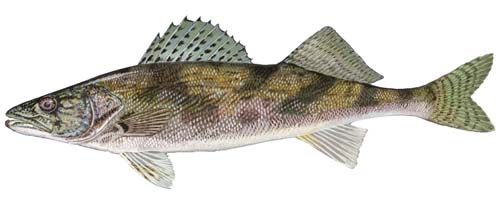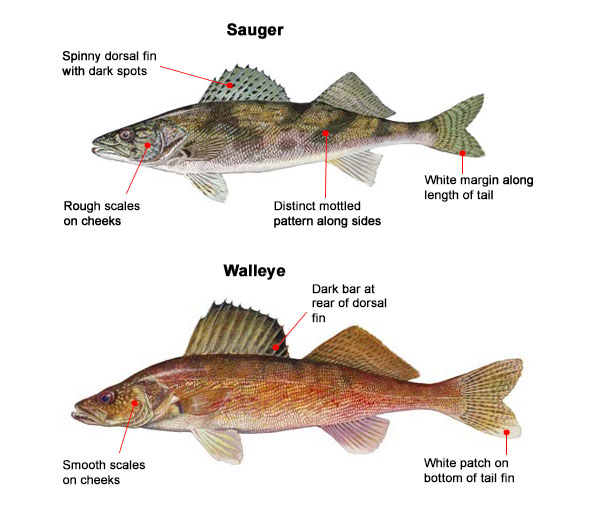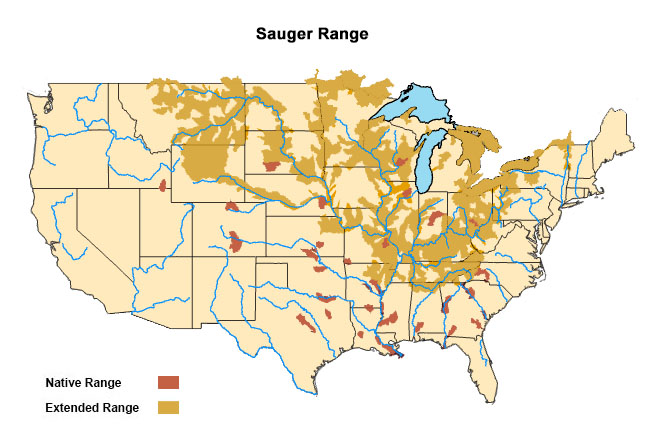Saugers are an aggressive game fish found in the southern, central, and western U.S. They live in lakes rivers and tributaries and are most often caught by trolling, drift fishing and still fishing. They will take both live baits and colorful lures.

Habitat: Lake, Pond
How to identify Sauger
Because sauger are close relatives of walleye, they look similar. Saugers can be identified by looking for a few unique features, particularly dark dots on their dorsal fins. Saugers are also missing the large marking at the end of their dorsal fin that is present in walleyes well as the walleye’s traditional white-tipped tail.

Saugers are also smaller than walleyes. An average adult sauger will measure between 12 and 15 inches and 2 to 3 lbs, with few exceptional specimens reaching over 20 inches and 12 lbs. The average adult walleye measures between 2 and 3 feet and can weight between 10 and 20 lbs, which a few larger specimens recorded.
A hybrid sub-species of a cross between a sauger and walleye, known as saugeye, adds to the confusion of being able to distinguish sauger from walleye. The sauger’s coloring is bronze or olive with a white belly.
Sauger spawning season runs from March to May.
Where to catch Sauger
Sauger can be found in the U.S. and Canada from central Alberta to Montana, southeasterly to Arkansas and Tennessee up to Quebec. They are found in James Bay to the Great Lakes, northerly to Ontario and Saskatchewan. Major rivers systems including the Illinois, Ohio and Mississippi have abundant sauger populations.

Compared to other fish species, sauger are extremely light sensitive. They’ll avoid any areas where the light penetrates the water. Sauger thrive in water with high turbidity and alkalinity. They prefer the dark, muddy waters of tributaries, lakes, rivers, and water reservoirs. They stick to warmer waters and will hide in vegetation.
Sauger are usually found at depths of at least 5 feet and hold to the deeper pools, holes, and main river basins. The prefer ares with little current and sand or silt subtrate. During the evening and night hours, of the warmer summer months, sauger will enter the shallows to forage and can be fished from shore.
Larger sauger can be found in some of the haunts as walleye including sandbars, gravel bars, points and humps. Larger sauger tend tolerate moderate current more than smaller sauger and are often found at the head of structure. Often where’s there’s walleye, you’ll find sauger a few feet deeper.
The following are habitats where you can catch Sauger:
- Cliffs and Steep Shore Banks
- Current Edges
- Dams and Falls
- Drop-offs
- Freshwater Lakes and Ponds
- Freshwater Weed Beds
- Gradual Shores
- Inlets and Outlets
- Inside Turns and Coves
- Islands or Sand Bars
- Lake and Pond Fishing Holes
- Open Water
- Outside of Bends
- Rivers and Streams
- Rock and Boulder Pockets
- Springs Holes
How to catch Sauger
Saugers are an aggressive feeders, yet they can be difficult to during day light hours when the sun is out. The best times to fish for sauger is in the early mornings and evenings. Because they are bottom-dwelling fish, fly fishing for sauger is challenging at best. The best methods for catching saugers include drift fishing, still fishing, vertical jigging and trolling.
Probably one of the most common methods for fishing sauger is with a jig. I don’t know a sauger that won’t readily take a jig tipped with a shiner if provided the opportunity. As a rule of thumb, shorter jig presentations tend to perform best when fishing low current conditions. When current is stronger, longer jigs catch more sauger. And when it comes to jig selection, think bright and bold.
A go-to walleye presentation, the Lindy rig, is almost as effective for fishing sauger. A 42″ Lindy rig with a #4 hook tipped with a shiner trolled at between 1.4 and 1.6 mph is the perfect setup to reel in sauger all day long. Just make sure not to drag your your weight along the bottom. A 45 degree line angle with your rig bounce periodically off the bottom is your goal.
The following are effective fishing methods and techniques for catching Sauger:
Best Lures, Bait & Tackle to catch Sauger
When using baits, choose crayfish, shad, small panfish, and minnows. For lures, try a brightly colored bucktail, spoon, or jig.
The following are fishing lures, bait and tackle that can be used to catch Sauger:



